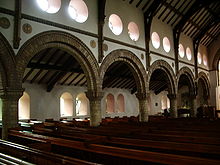- St Paul's Church, Scotforth
-
St Paul's Church, Scotforth 
St Paul's Church, Scotforth, from the northeastCoordinates: 54°02′01″N 2°47′44″W / 54.0336°N 2.7955°W OS grid reference SD 479 600 Location Scotforth, Lancaster, Lancashire Country England Denomination Anglican Website St Paul's, Scotforth History Founded 11 August 1874 Dedication Saint Paul Consecrated 18 February 1876 Architecture Status Parish church Functional status Active Heritage designation Grade II Designated 25 October 1985 Architect(s) Edmund Sharpe
Paley, Austin and PaleyArchitectural type Church Style Romanesque Revival Completed 1891 Specifications Capacity 350 Administration Parish St Paul, Scotforth Deanery Lancaster Archdeaconry Lancaster and Morecambe Diocese Blackburn Province York Clergy Vicar(s) Rev Michael Gisbourne Curate(s) Rev Olaf Trelenberg Laity Reader Mr J. W. Fidler
Prof A. M. Guenault
Dr M. C. IvesSt Paul's Church, Scotforth, is in Scotforth, a suburb of Lancaster, Lancashire, England. It has been designated by English Heritage as a Grade II listed building.[1] It is an active Anglican parish church in the deanery of Lancaster, the archdeaconry of Lancaster and Morecambe, and the diocese of Blackburn.[2] The architectural historian Nikolaus Pevsner described it as a "strange building" and "an anachronism, almost beyond belief".[3]
Contents
History
St Paul's was designed by Edmund Sharpe, an architect who established a practice in Lancaster in 1835. In 1838 E. G. Paley joined him as a pupil. In 1845 he became a partner and Sharpe retired from the practice in 1851.[4] He then pursued a career in railway engineering.[5] In 1874, when he was aged 68, he returned to architecture and designed this church which was opened in 1876.[3] Sharpe lived in a house within 300 yards (274 m) of the church. The foundation stone was laid on 11 August 1874. The church was almost finished by the end of 1875, and it was consecrated on 18 February 1876 by Rt Revd James Fraser, Bishop of Manchester.[6] In 1890–91 the west end of the church was extended, and transepts were added by Paley, Austin and Paley, the successors in Sharpe's former practice.[7]
Architecture
Exterior
The church is in Romanesque style.[8] Pevsner points out that while this style (which he calls Neo-Norman) was fashionable in the 1840s, it was out of fashion in the 1870s, when the usual style was Gothic Revival.[7] Sharpe himself argued that the style was late Transitional of about 1170.[6]
The church is built in brick, faced on the outside with local gritstone, and with yellow terracotta dressings. Its plan consists of a five-bay nave with aisles, a clerestory and transepts at the western end. The chancel has one bay, over which is the tower. To the east of the chancel is an apsidal sanctuary and to the north is a vestry. The west façade has two lancet windows with a round window above. The bays are separated by buttresses, each bay containing two round-arched windows in the aisles and two round windows in the clerestory. The tower has two round-headed windows on the north and south sides in the lower stage. Above this is a tall bell chamber with two large arched openings on each face. The roof is hipped with steep gables on the east and west faces, each containing a vesica piscis opening. It is covered in lead. The apse has a half-conical roof; it is divided into three bays by buttresses, each bay containing a round-headed window.[1]
Interior
The arcades consist of round columns with square capitals carrying round arches. They are clad with terracotta. The chancel has a quadripartite rib vaulted ceiling and blank arcading on the north and south walls. The ceiling of the apse is painted.[7] The pews stretch between the arcades with no central aisle. The font is large and made from pink marble.[1] The stained glass at the west end dates from about 1897, depicts the Works of Mercy, and is by Barrowclough & Sanders. Two windows in the south aisle date from the 1920s and are probably by Shrigley & Hunt.[7] In the chancel are memorial brasses to Edmund Sharpe and to his wife.[9]
See also
- List of architectural works by Edmund Sharpe
- List of works by Paley, Austin and Paley
Notes
- ^ a b c "Church of St Paul, Lancaster", The National Heritage List for England (English Heritage), 2011, http://list.english-heritage.org.uk/resultsingle.aspx?uid=1288582, retrieved 7 August 2011
- ^ St Paul, Scotforth, Lancaster, Church of England, http://www.achurchnearyou.com/lancaster-st-paul-scotforth/, retrieved 7 April 2011
- ^ a b Hartwell & Pevsner 2009, p. 401.
- ^ Price 1998, pp. 4–5.
- ^ O'Donoghue, F. M., rev. Geoffrey K. Brandwood, (2004) Sharpe, Edmund (1809-1877), Oxford Dictionary of National Biography, Oxford University Press , Retrieved on 18 August 2009 Subscription or UK public library membership required
- ^ a b Hughes 2010, pp. 270–282.
- ^ a b c d Hartwell & Pevsner 2009, p. 402.
- ^ Price 1998, p. 69.
- ^ Hughes 2010, p. 282.
Bibliography
- Hartwell, Clare; Pevsner, Nikolaus (2009) [1969], The Buildings of England. Lancashire: North, New Haven and London: Yale University Press, ISBN 978-0-300-12667-9
- Hughes, John M. (2010), Edmund Sharpe: Man of Lancaster, John M. Hughes
- Price, James (1998), Sharpe, Paley and Austin: A Lancaster Architectural Practice 1836–1942, Lancaster: Centre for North-West Regional Studies, ISBN 1-86220-054-8
Categories:- Church of England churches in Lancashire
- Grade II listed churches
- Grade II listed buildings in Lancashire
- Romanesque Revival architecture in England
- Religious buildings completed in 1876
- 19th-century church buildings
- Diocese of Blackburn
- Edmund Sharpe buildings
- Paley, Austin and Paley buildings
- Terracotta
- Buildings and structures in Lancaster
Wikimedia Foundation. 2010.

